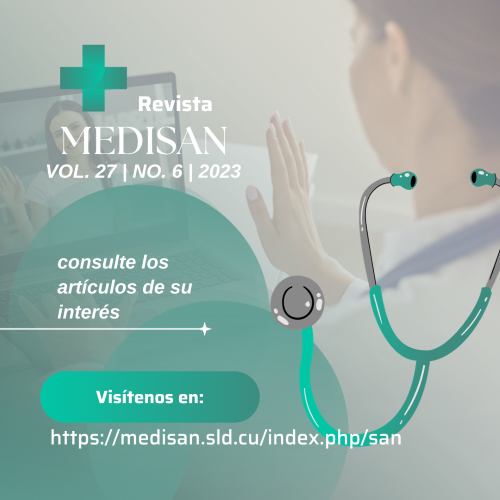Rechazo de donantes de sangre en un hospital peruano durante la pandemia de la covid-19
Palabras clave:
donantes de sangre, selección de donante, bancos de sangre, seguridad de la sangre, infecciones por coronavirus, Perú.Resumen
Introducción: El SARS-CoV-2 ha tenido un impacto negativo y significativo en los sistemas de salud a nivel mundial, lo cual además amenazó el suministro de sangre necesario para las transfusiones clínicas.
Objetivo: Describir las causas del rechazo de donantes de sangre durante la pandemia de covid-19.
Métodos: Se realizó un estudio observacional, transversal y retrospectivo en una población de donantes que acudió al Banco de Sangre del Hospital Nacional Ramiro Prialé Prialé, de Huancayo, en Perú, de julio del 2020 a igual mes del 2022. Las variables analizadas fueron sexo, grupo sanguíneo ABO, factor Rh y tipos y causas de rechazo.
Resultados: Del total de 10 177 donantes de sangre, fueron diferidos y excluidos 3390 (33,3 %); la causa más frecuente de diferimiento fue el hematocrito bajo (18,0 %) y la de exclusión, la positividad por el anticuerpo del núcleo de la hepatitis B (36,8 %). Asimismo, predominó el sexo masculino entre los que fueron rechazados (55,2 %) y se evidenció un incremento de la tendencia politómica en los donantes diferidos (R²=0,2214) y excluidos (R²=0,1178).
Conclusiones: La prevalencia de diferimiento y exclusión de donantes de sangre hallada en esta serie fue relativamente alta en comparación con la registrada en otros estudios, lo cual se debió principalmente, en cada caso respectivo, al hematocrito bajo y a la presencia del anticuerpo del núcleo de la hepatitis B.
Descargas
Citas
2. Organización Mundial de la Salud. Disponibilidad y seguridad de la sangre. Ginebra: OMS; 2023 [citado 30/10/2023]. Disponible en: https://www.who.int/es/news-room/fact-sheets/detail/blood-safety-and-availability
3. Organización Panamericana de la Salud; Organización Mundial de la Salud. Suministro de sangre para transfusión en países de América Latina y el Caribe (2020*). Washington, D.C.: OPS; 2020 [citado 01/15/2023]. Disponible en: https://www.paho.org/es/temas/sangre/suministro-sangre-para-transfusion-paises-america-latina-caribe-2020
4. Minsa invoca a la población a ser donantes voluntarios de sangre. El Peruano. 15 Feb 2022 [citado 01/15/2023]. Disponible en: https://elperuano.pe/noticia/139438-minsa-invoca-a-la-poblacion-a-ser-donantes-voluntarios-de-sangre
5. EsSalud: Donación de sangre durante la pandemia disminuyó en 70 % y solo el 1 % de peruanos lo hace voluntariamente. EsSalud. 10 Ago 2022 [citado 01/15/2023]. Disponible en: http://noticias.essalud.gob.pe/?inno-noticia=essalud-donacion-de-sangre-por-la-pandemia-disminuyo-en-70-y-solo-el-1-de-peruanos-lo-hace-voluntariamente
6. Wang Y, Han W, Pan L, Wang C, Liu Y, Hu W, et al. Impact of COVID‐19 on blood centres in Zhejiang province China. Vox Sanguini. 2020 [citado 01/15/2023];115(6):502-6. Disponible en: https://onlinelibrary.wiley.com/doi/pdfdirect/10.1111/vox.12931?download=true
7. Herrera C, Martínez C, Armanet L, Cárcamo A, Boye P, Lyng C. Blood donation in Chile: Replacement and volunteer donors. Biologicals. 2010 [citado 01/15/2023];38(1):36-8. Disponible en: https://www.sciencedirect.com/science/article/abs/pii/S1045105609001626?via%3Dihub
8. Moraga Salazar AJ, Castro Artavia E, Mora Fallas JP. Aseguramiento del abastecimiento de sangre, recambio plasmático terapéutico y plasma convaleciente durante la pandemia de COVID-19. Rev Colegio de Microb Quím Clín. Costa Rica. 2021 [citado 01/15/2023];26(1):45-59. Disponible en: http://revista.microbiologos.cr/wp-content/uploads/2021/03/Vol.-26-N%C2%BA-1-enero-abril-2021-art%C3%ADculo-5.pdf
9. Centro Nacional de la Transfusión Sanguínea. Actualización del lineamiento técnico para la selección y diferimiento de donantes en México, en relación al Coronavirus 2019-COVID-19 y otras infecciones respiratorias agudas. Ciudad de México: Secretaría de Salud; 2020 [citado 30/11/2023]. Disponible en: https://www.ammtac.org/docs/articulos/LINEAMIENTO%20CNTS%20DONACION%20Y%20CORONAVIRUS.pdf
10. Bansal N, Raturi M. COVID-19 vaccination in the Indian blood donors: Adjudging the impact on the deferral period. Transfusion Clinique et Biologique. 2021;28(3):310-2.
11. República del Perú. Ministerio de Salud. Resolución Ministerial. Lima: MINSA; 2022 [citado 01/15/2023]. Disponible en: http://bvs.minsa.gob.pe/local/covid/boletin/RM-212-2022-MINSA.pdf
12. Guillen Macedo K, Vilca Mamani N, Renzo Aquino-Canchari C. Causas de rechazo de donantes de sangre de un hospital del sur peruano. Rev Cuban Invest Bioméd. 2020 [citado 30/11/2023];39(3):e619. Disponible en: http://scielo.sld.cu/pdf/ibi/v39n3/1561-3011-ibi-39-03-e619.pdf
13. Birjandi F, Gharehbaghian A, Delavari A, Rezaie N, Maghsudlu M. Blood donor deferral pattern in Iran. Arch Iran Med. 2013 [citado 30/11/2023];16(11):657-60. Disponible en: http://journalaim.com/PDF/43_Nov013_009.pdf
14. Valerian DM, Mauka WI, Kajeguka DC, Mgabo M, Juma A, Baliyima L, et al. Prevalence and causes of blood donor deferral among clients presenting for blood donation in northern Tanzania. PLoS One. 2018 [citado 16/11/2023];13(10):e0206487. Disponible en: https://journals.plos.org/plosone/article/file?id=10.1371/journal.pone.0206487&type=printable
15. Baart AM, Van Den Hurk K, LAM de Kort W. Minimum donation intervals should be reconsidered to decrease low hemoglobin deferral in whole blood donors: an observational study. Transfusion. 2015 [citado 30/11/2023];55(11):2641-4. Disponible en: https://onlinelibrary.wiley.com/doi/pdfdirect/10.1111/trf.13195?download=true
16. Urbina A, García Otálora MA, Mendoza Romero D, Rocha F, Rodriguez A, Palomino F, et al. Deferral due to low hemoglobin and predictors of permanence in the blood donation system of repeat female blood donors. Transfus Apher Sci. 2022 [citado 30/11/2023];61(3):103340. Disponible en: https://www.sciencedirect.com/science/article/pii/S1473050221003487?via%3Dihub
17. Iqbal H, Tameez Ud Din A, Tameez Ud Din A, Mohyud Din Chaudhary F, Younas M, Jamil A. Frequency and Causes of Deferral among Blood Donors Presenting to Combined Military Hospital Multan. Cureus. 2020 [citado 30/11/2023];12(1):e6657. Disponible en: https://www.ncbi.nlm.nih.gov/pmc/articles/PMC7017926/pdf/cureus-0012-00000006657.pdf
18. Okoroiwu HU, Asemota EA. Blood donors deferral prevalence and causes in a tertiary health care hospital, southern Nigeria. BMC Health Service Research. 2019 [citado 16/11/2023];19:510. Disponible en: https://bmchealthservres.biomedcentral.com/counter/pdf/10.1186/s12913-019-4352-2.pdf
19. Bansal N, Raturi M, Bansal Y. Seroprevalence of SARS-CoV-2 among blood donors: A practical serosurveillance tool for COVID-19. Transfusion Clinique et Biologique. 2022 [citado 16/11/2023];29(2):182-3. Disponible en: https://doi.org/10.1016/j.tracli.2021.11.005
20. Ene JC, Ajibo HT. Covid-19 Recovery and Growth: Promoting Technology Innovation in Healthcare Sector on Hygiene and Safe Medication Practices in Low-Resourced Nigerian Societies. Scientific African. 2023 [citado 16/11/2023];19:e01542. Disponible en: https://doi.org/10.1016/j.sciaf.2023.e01542
Publicado
Cómo citar
Número
Sección
Licencia
Esta revista provee acceso libre e inmediato a su contenido bajo el principio de que hacer disponible gratuitamente investigación al público, apoya aún más el intercambio de conocimiento global. Esto significa que los autores/as conservarán sus derechos de autor y garantizarán a la revista el derecho de primera publicación de su obra, el cuál estará simultáneamente sujeto a la licencia internacional Creative Commons Atribución 4.0 que permite copiar y redistribuir el material en cualquier medio o formato para cualquier propósito, incluso comercialmente, además de remezclar, transformar y construir a partir del material para cualquier propósito.




